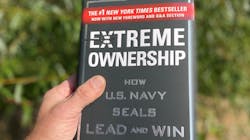Jocko Willink and Leif Babin retired from the U.S. Navy SEALs after serving honorably and have gone on to leave an indelible mark on countless lives with their 2015 book, Extreme Ownership: How U.S. Navy SEALs Lead and Win. The number of teams in our industry alone who are utilizing these principles never ceases to amaze me. We often say that our industry is inherently dangerous, but there is a tremendous amount of effort that focuses on mitigating the hazards. We own the risks associated with high voltage current, working in remote and rugged areas, dealing with the public, and operating all types of vehicles and equipment. We also must factor in major storms, wildfires and now a global pandemic. We have no choice except to own these risks because they directly affect the myriad of other tasks that we perform and the lives of our essential workers.
The book is great for any level within an organization but prepare yourself for a hard look in the mirror right upfront. Early in the book, the authors address the concepts that, “there are no bad teams, only bad leaders” and there are “only two types of leaders: effective and ineffective” to deliver the point that owners lead, owners take full responsibility.
The idea of extreme ownership is that whatever happens in my world is my responsibility. I own every issue in my operation, even the ones I have no control over. Together we share the good and bad, we can also take ownership of helping others solve an issue. If everyone on your team adopts this, you’ll stop looking for fault and start finding solutions. Safety is a core value of many organizations including ours. We also ask our employees to consider their commitment to ownership of their safety, a moral imperative as well.
Willink and Babin seamlessly link leadership experiences from the battlefield to principles that have application across the business spectrum. Understanding how to implement these lessons will allow your organization to operate safely, and at a higher standard, regardless of size.
Another concept addressed by the authors is the SEAL’s Laws of Combat. These laws of combat are Simple, Cover and Move, Prioritize and Execute, and lastly Decentralized Command.
The first law, Simple, explains how complex situations can be safely completed by clear, concise, and repeatable communication. A leader has to understand and explain the big picture including why it is important. What is the strategy and which tactics will we use to achieve the goal? What are the roles and responsibilities of every team member? Collective shared consciousness is only achieved when the lowest common denominator on the team understands his or her role and owns how it fits into the success of the bigger picture. A questioning attitude is key here, if someone on your team doesn’t understand or ask, you have to own that as a leader and address it.
Cover and Move is all about understanding intent and how to take advantage of all available options for support. Communication is again a key component, speculation and assumption lead to errors. A solid job brief and the delivery of intent confirmed through three-way communication keeps everyone in the loop. When teams take an “us” approach instead of “them”, it becomes much easier to build trust and mentor those who need extra support. In the safety realm as leaders, we should have our employees back even when they make a bad decision because we should be providing training and intent that guides good decisions and initiatives.
If the strategy is simple, and we are trained with a clear understanding of the intent, being decisive when it matters is the next law: prioritize and execute. We can only control the choices we make but must understand that those choices may affect others. Having a clear understanding of the things that we can influence and control is foundational to prioritizing. Too often we get wrapped up in the moment and lose sight of the objective. This can happen when we haven’t fully understood the plan and owned our respective role, which may be critical not only to the overall objective but have an effect on other individuals’ part in the process. Once we master prioritizing the critical steps to safely complete the task, we execute on those plans. When everyone on the team is prioritizing and executing, it is much easier to be decisive when unexpected changes occur.
Decentralized Command is the fourth and final of the SEAL’s Laws of Combat and is not a new concept. High performing teams typically have long since moved on from the traditional command and control architecture to the shared consciousness approach of many small teams collaborating to accomplish the goal. It is beyond difficult for one individual to foresee every challenge or attempt to manage every aspect of an operation. When we engage the individuals to take ownership and have established a plan that is understood and trusted, ideas, creativity, and solutions flow allowing goals to be consistently met.
In the words of the authors “get after it!” and grab a copy of Extreme Ownership (Willink, J., & Babin, L. (2015). Extreme Ownership: How U.S. Navy SEALs lead and win. New York, NY: St. Martin's Press).
About the Author
Keith Pancake
Keith Pancake is a safety manager serving ACRT and Bermex. He has been involved in the UVM industry for over 10 years. He is an ISA Certified Arborist and Utility Specialist, an NSC certified Defensive Driving Instructor, and the 2018 Utility Arborist Association’s Silver Shield recipient.
